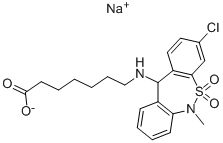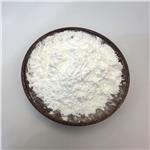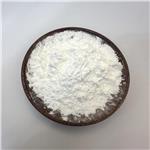Description
Tianeptine sodium salt is a salt of Tianeptine. Tianeptine is an atypical antidepressant. It is an agonist of the μ-opioid receptor (MOR; EC50s = 194 and 641 nM for human and mouse receptors, respectively, in a BRET assay for G protein activation) and also has effects on the glutamate system. Tianeptine (30 mg/kg) decreases immobility in the forced swim test in wild-type, but not MOR knockout mice, indicating antidepressant-like activity dependent on MORs. It increases locomotor activity at a dose of 30, but not 10 mg/kg, in the open field test and increases paw withdrawal latency in the hot-plate test in mice. Tianeptine modulates AMPA receptor activity by increasing phosphorylation of the AMPA receptor GluR1 subunit in the frontal cortex and hippocampal CA3 region in mice. It prevents increases in glial glutamate transporter 1 (GLT-1) expression induced by chronic restraint stress in the hippocampal CA3 region in rats when administered at a dose of 10 mg/kg per day for 21 days.5It also reverses increases in extracellular glutamate levels induced by acute restraint stress in the basolateral nucleus of the amygdala in rats.
Appearance
White to pale yellow solid.
biological activity
Tianeptine sodium salt is a selective facilitator of 5-HT uptake in vitro and in vivo. IC50 Value:Target: 5-HT ReceptorTianeptine has no affinity for a wide range of receptors, including 5-HT and dopamine (IC50 > 10 μM) and has no effect on noradrenalin or dopamine uptake. Antidepressant, analgesic and neuroprotective following systemic administration in vivo.
Biochem/physiol Actions
Tianeptine is a tricyclic antidepressant that enhances serotonin uptake. This drug can affect neuroprotection, neuronal excitability, memory and anxiety. However, tianeptine is not linked to adverse psychomotor, cognitive, cardiovascular, sleep and bodyweight effects. The drug has a low tendency for abuse and has a positive pharmacokinetic profile.
Tianeptine is least involved in drug interaction as it is not metabolized by cytochrome P450 system in the liver. In hippocampus and amygdala, tianeptine is involved in glutamatergic transmission processes and elicits neuroplasticity.
Laboratory Procedures
Tianeptine (sodium salt) is supplied as a crystalline solid. A stock solution may be made by dissolving the tianeptine (sodium salt) in the solvent of choice. Tianeptine (sodium salt) is soluble in organic solvents such as ethanol, DMSO, and dimethyl formamide, which should be purged with an inert gas. The solubility of tianeptine (sodium salt) in these solvents is approximately 10, 20, and 30 mg/ml, respectively. Further dilutions of the stock solution into aqueous buffers or isotonic saline should be made prior to performing biological experiments. Ensure that the residual amount of organic solvent is insignificant, since organic solvents may have physiological effects at low concentrations. Organic solvent-free aqueous solutions of tianeptine (sodium salt) can be prepared by directly dissolving the crystalline solid in aqueous buffers. The solubility of tianeptine (sodium salt) in PBS, pH 7.2, is approximately 10 mg/ml. We do not recommend storing the aqueous solution for more than one day.
Description
Tianeptine sodium salt is a structurally novel, serotonin specific antidepressant. It is useful in the treatment of neurotic and reactive depressions, as well as depressive states accompanied by anxiety. Tianeptine (sodium salt) is an analytical reference standard categorized as an opioid. Tianeptine has been abused and associated with overdose and death. Formulations containing tianeptine have been used in the treatment of depression. This product is intended for use in analytical forensic applications. This product is also available as a general research tool .
Originator
Sci. Union et Cie (France)
Uses
Tianeptine sodium salt is a tricyclic compound with psychostimulant, anti-ulcer and anti-emetic properties. Tianeptine sodium salt hydrate has been used as a selective serotonin reuptake enhancer (SSRE) positive control during serotonin transporter (SERT) assay in human embryonic kidney 293 cell lines. Tianeptine (INN) (Stablon, Coaxil, Tatinol) is a SSRE drug used for treating major depressive episodes (mild, moderate, or severe). Tianeptine commonly used for depression. It is also used for pain, asthma, anxiety, and many other conditions, but there is no good scientific evidence to support these other uses.
Manufacturing Process
A solution of 27.6 g (0.16 mol) of freshly distilled ethyl 7-aminoheptanoate in
40 ml of nitromethane was added all at once and with mechanical stirring to a
suspension of 26.2 g (0.08 mol) of 5,8-dichloro-10-dioxo-11-
methyldibenzo[c,f]thiazepine(1,2) in 120 ml of nitromethane. The whole was
heated to 55°C for 30 minutes, the solvent was then evaporated in vacuo and
the residue was taken up in water. The crude ester was extracted with ether.
After evaporation of the ether 36 g of crude ester were obtained, and 30 g
(0.065 mol) there of were treated under reflux with a solution of 2.8 g (0.07
mol) of sodium hydroxide in 35 ml of ethanol and 25 ml of water. After one
hour's refluxing, the alcohol was evaporated in vacuo. The residue was taken
up in 150 ml of water.
The mixture was twice extracted with 75 ml of chloroform and the aqueous
phase was evaporated in vacuo. The sodium salt was then dissolved in 150 ml
of chloroform, the solution was dried over sodium sulfate and the product
precipitated with anhydrous ether.
The salt was filtered off, washed with ether and dried at 50°C. 13 g of sodium
7-[8-chloro-10-dioxo-11-methyldibenzo[c,f]thiazepin-(1,2)-aminoheptanoate,melting with decomposition at about 180°C, were obtained.
Therapeutic Function
Antidepressant
General Description
Tianeptine is a μ-opioid receptor (MOR) as well as a δ-opioid receptor (DOR) agonist.
Biological Activity
Selective facilitator of 5-HT uptake in vitro and in vivo . Has no affinity for a wide range of receptors, including 5-HT and dopamine (IC 50 > 10 μ M) and has no effect on noradrenalin or dopamine uptake. Antidepressant, analgesic and neuroprotective following systemic administration in vivo .
Biochem/physiol Actions
Tianeptine is a tricyclic antidepressant that enhances serotonin uptake. This drug can affect neuroprotection, neuronal excitability, memory and anxiety. However, tianeptine is not linked to adverse psychomotor, cognitive, cardiovascular, sleep and bodyweight effects. The drug has a low tendency for abuse and has a positive pharmacokinetic profile.
References
1)?Mennini?et al. (1987),?Tianeptine, a selective enhancer of serotonin uptake in rat brain; ?Naunyn-Schmied. Arch. Pharmacol.,?336?478
2)?Kato and Weitsch (1988),?Neurochemical profile of tianeptine, a new antidepressant drug; ?Clin. Neuropharmacol.,?11?S43
3)?Plaisant?et al. (2003),?Neuroprotective properties of tianeptine: interactions with cytokines; Neuropharmacology,?44?801
4)?Seo?et al. (2016),?Tianeptine induces mTORC1 activation in rat hippocampal neurons under toxic conditions; ?Psychopharmacology (Berl.),?233?2617
5)?Slusarczyk?et al. (2017),?Anti-inflammatory properties of tianeptine on lipopolysaccharide-induced changes in microglial cells involve toll-like receptor-related pathways; ?J. Neurochem.,?136?958




